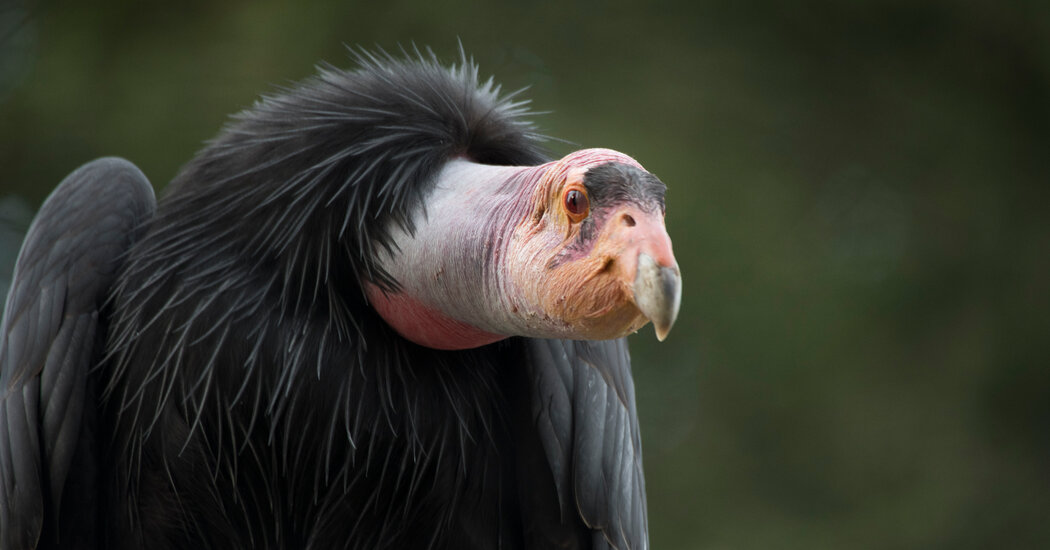For two months this spring, a pair of California condor parents carefully tended to a single, enormous egg. They took turns sitting on the egg to keep it warm, and they routinely rotated the egg, a behavior believed to promote proper chick development.
What the birds, part of a breeding population at the Oregon Zoo, did not appear to notice was that the egg was a high-tech fraud. The plastic shell, made with a 3-D printer, was stuffed with sensors designed to surreptitiously monitor conditions inside the condors’ nest.
For weeks, the dummy egg tracked the nest temperature, logged the birds’ egg-turning behaviors and recorded the ambient sound. The zoo hopes this data will allow it to better replicate natural conditions in the artificial incubators that are key to its condor breeding efforts.
California condors, which can have wingspans of nearly 10 feet, are critically endangered. So every year, when the birds lay their eggs, the zoo whisks them out of the nest and into the safety of the incubators. This strategy has several advantages, prompting some pairs to lay a second egg, enabling the zoo to monitor embryo development and protecting the fragile embryos from condor rowdiness.
“During breeding season, tensions tend to run high,” said Kelli Walker, the zoo’s senior condor keeper. “And occasionally pairs will get into a fight in the nest room and by accident injure the egg.” (The chicks are returned to the nest when they begin hatching.)
The more closely the zoo can replicate natural conditions in the incubators, the more successful it will be. So Ms. Walker enlisted Scott Shaffer, an animal ecologist and bird researcher at San Jose State University, and Constance Woodman, a bird scientist and expert on conservation technology at Texas A&M University, who together have made data-logging smart eggs for many different bird species.
Here’s how they brought the condor eggs into being:
Design the eggs
Dr. Woodman created a digital model of the imitation condor egg. The shell had to be thin enough for the internal sensors to detect temperature changes but robust enough to withstand potential avian abuse. (A macaw once threw one of Dr. Woodman’s eggs out of its nest, two stories off the ground.) To ensure the egg would not pop open, she designed threaded shell halves that would screw together tightly. “It will stay closed unless you’ve got thumbs,” she said. “Birds do not have thumbs, so we’re in good shape.”
Print the shells
Dr. Woodman used a 3-D printer loaded with a plastic selected specifically to be safe for birds, which might spend months sitting on the eggs. “I really, really don’t want to mean well and poison a bird,” she said. Printing each shell took 13 hours.
Enlist the test turkey
To ensure that the egg was not prone to spinning or wobbling, Dr. Woodman gave it to Loretta, her litter-box-trained “house turkey,” she said. “If Loretta doesn’t like it, she won’t sit on it.”
Dye the eggs
The color of bird eggs varies by species, and Dr. Woodman and Dr. Shaffer always try to replicate it as closely as possible. To match the subtle, blue-green tint of condor eggs, Dr. Woodman dipped the shells into a pot of a nontoxic dye intended for children’s clothing.
Add the electronics
Small data loggers tucked inside the shells can track the temperature and movement of the eggs. An audio recorder captures the sounds in the nest, which the zoo will play back to the eggs in the incubator. “Developing embryos can hear things through their shells,” Ms. Walker said. And she used electrical tape to cover the lights on the electronics, “otherwise it would have looked like a flashing Christmas egg.”
Weigh them down
Some birds will reject eggs that are abnormally light. So Ms. Walker used a hot glue gun to attach rocks to the inside of the egg, bringing its weight to more than half a pound.
Make the swap
The first condor parents to receive a smart egg this year were a female known only as number 762 and her mate, Alishaw. “He’s not what you would call a traditionally fantastic dad,” Ms. Walker said. “He’ll incubate as long as he has to, but he’s not thrilled about it.” (762’s devotion to him, however, remains undimmed. “She’s kind of a ride-or-die with Alishaw,” Ms. Walker said.)
When both birds left the nest, zoo staff moved their real egg to an incubator and replaced it with the fake one. The condors did not seem to notice. (Their chick, which has since hatched, is back with its parents and doing well, Ms. Walker said.)
Analyze the data
When the breeding season is over, Dr. Shaffer and Ms. Walker will analyze the data. The findings will inform future incubator settings and, the team hopes, help bring more California condor chicks safely into the world. “It’s just a really cool use of technology that will only get better,” Dr. Shaffer said.
Source: Read Full Article
